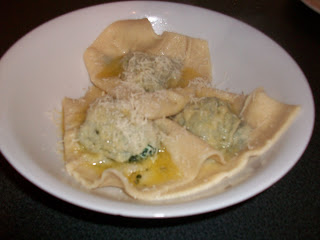I have to confess to feeling pretty pleased with myself right now. I'm sitting writing this with a cup of tea and a homemade cookie. Not just any homemade cookie I should add but one from a recipe of my own creation. I know I didn't invent the concept but not being able to find a British recipe (i.e. one that didn't require a cup of butter, as if anyone can get butter into a cup to measure it!) I thought I would just try and adapt a well-tested cookie recipe. I didn't expect it to be successful the first time but to my surprise, it was! These cookies have a special place in my heart as I first ate one last year while the husband and I were on honeymoon. Since then I have often thought about their firm yet chewy texture, double chocolately taste and deep red colour but have been too afraid to try them for fear of spoiling the idea of them forever. They may just be a slightly fancy chocolate chip cookie with some cocoa powder and red food colouring but they've certainly made my weekend!
I used:
100g soft butter
100g light brown sugar
1 tbsp golden syrup
135g self raising flour
15g cocoa powder
1/2 tsp vanilla extract
50g white chocolate, cut into fairly small chunks (or you could use white chocolate chips)
1 tsp red food colouring
Makes 20
Pre heat the oven to 170°C
Cream together the butter and sugar. When light and fluffy, add the golden syrup and vanilla extract.
Add the flour, cocoa power and chocolate and mix until it starts to clump together then add the food colouring and finish bringing together by hand (I wore snazzy latex gloves so I didn't have to spend three days with red hands). I have said one teaspoon of colouring as this is roughly what I used but it will depend on how red you want the cookies to be and also on the colouring you are using. If you are using the colouring paste then you will need even less. I keep meaning to get some of that but somehow never get around to it so turn to the trusty bottles of colouring in my baking drawer. If you're feeding kids then the paste is definitely a much better investment. You are aiming for a deep burgundy colour to the dough as the colour will change during cooking.
Roll small pieces of the dough into a ball, don't flatten them, and put them on a greased baking sheet leaving at least an inch all the way around each ball of dough. At this point they look like little meatballs on a tray but once in the oven they will flatten themselves and spread into cookie shapes.
Bake in the oven for 10-12 minutes until they start to firm up at the edges.
I made smaller cookies but if you wanted bigger ones just make bigger balls of dough and leave more room around them.
I say this makes twenty cookies but twenty one balls of dough went into the oven, I ate the other one the second they came out before they had started to firm up. And I'm not sorry either.







